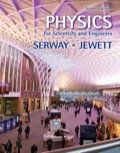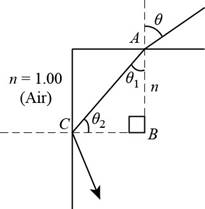
Concept explainers
(a)
The maximum angle of incidence for which the phenomena of total internal reflection occurs at the left vertical surface.
(a)
Answer to Problem 35.68AP
Explanation of Solution
Given Info: The light of wavelength
The refractive index of the polystyrene is

Figure (I)
For total internal reflection from the left vertical surface the angle of incidence for the vertical surface must be greater than the critical angle.
The formula to calculate the critical angle is,
Here,
Substitute
From equation (1) the value of the angle
From Figure (1) in triangle
Substitute
Thus the value of
Formula to calculate the value of
Here,
Substitute
As the angle
Thus any value of
Conclusion:
Therefore, total internal reflection will occur at the left vertical surface for any angle less than
(b)
The angle of incidence if the polystyrene slab is immersed in water.
(b)
Answer to Problem 35.68AP
Explanation of Solution
Explanation
Given info: The refractive index of water is
For the polystyrene slab surrounded in water the value of critical angle is,
Substitute
The value of
From figure (1) in triangle
Substitute
From Snell’s Law, calculate the value of the angle of incidence.

Here,
Substitute
Thus when the polystyrene slab is immersed in water the angle of incidence is
Conclusion:
Therefore, the total internal reflection will occur for angle of incidence
(c)
The angle of incidence for the phenomena of total internal reflection if the polystyrene slab is immersed in carbon disulphide.
(c)
Answer to Problem 35.68AP
Explanation of Solution
Explanation
Given info: The refractive index of carbon disulphide is
The phenomena of total internal reflection only takes place when the light ray is travelling form a higher refractive index material to a low refractive index material.
For the case where the polystyrene slab is immersed in the carbon disulphide the light ray at the interface of the left vertical wall will not undergo the total internal reflection as at the interface the light will be propagating form a lower refractive index material to a higher refractive material and for the phenomena of total internal reflection to occur the light must be travelling form higher refractive index material to a low refractive index material.
Hence, the phenomena of total internal reflection will not take place when the slab is immersed in carbon disulphide.
Conclusion:
Therefore, the phenomena of total internal reflection will not take place when the slab is immersed in carbon disulphide.
Want to see more full solutions like this?
Chapter 35 Solutions
EBK PHYSICS FOR SCIENTISTS AND ENGINEER
- 20. Two small conducting spheres are placed on top of insulating pads. The 3.7 × 10-10 C sphere is fixed whie the 3.0 × 107 C sphere, initially at rest, is free to move. The mass of each sphere is 0.09 kg. If the spheres are initially 0.10 m apart, how fast will the sphere be moving when they are 1.5 m apart?arrow_forwardpls help on allarrow_forwardpls help on thesearrow_forward
- pls help on all asked questions kindlyarrow_forwardpls help on all asked questions kindlyarrow_forward19. Mount Everest, Earth's highest mountain above sea level, has a peak of 8849 m above sea level. Assume that sea level defines the height of Earth's surface. (re = 6.38 × 106 m, ME = 5.98 × 1024 kg, G = 6.67 × 10 -11 Nm²/kg²) a. Calculate the strength of Earth's gravitational field at a point at the peak of Mount Everest. b. What is the ratio of the strength of Earth's gravitational field at a point 644416m below the surface of the Earth to a point at the top of Mount Everest? C. A tourist watching the sunrise on top of Mount Everest observes a satellite orbiting Earth at an altitude 3580 km above his position. Determine the speed of the satellite.arrow_forward
- pls help on allarrow_forwardpls help on allarrow_forward6. As the distance between two charges decreases, the magnitude of the electric potential energy of the two-charge system: a) Always increases b) Always decreases c) Increases if the charges have the same sign, decreases if they have the opposite signs d) Increases if the charges have the opposite sign, decreases if they have the same sign 7. To analyze the motion of an elastic collision between two charged particles we use conservation of & a) Energy, Velocity b) Momentum, Force c) Mass, Momentum d) Energy, Momentum e) Kinetic Energy, Potential Energyarrow_forward
 Physics for Scientists and Engineers: Foundations...PhysicsISBN:9781133939146Author:Katz, Debora M.Publisher:Cengage Learning
Physics for Scientists and Engineers: Foundations...PhysicsISBN:9781133939146Author:Katz, Debora M.Publisher:Cengage Learning Physics for Scientists and EngineersPhysicsISBN:9781337553278Author:Raymond A. Serway, John W. JewettPublisher:Cengage Learning
Physics for Scientists and EngineersPhysicsISBN:9781337553278Author:Raymond A. Serway, John W. JewettPublisher:Cengage Learning Physics for Scientists and Engineers with Modern ...PhysicsISBN:9781337553292Author:Raymond A. Serway, John W. JewettPublisher:Cengage Learning
Physics for Scientists and Engineers with Modern ...PhysicsISBN:9781337553292Author:Raymond A. Serway, John W. JewettPublisher:Cengage Learning Principles of Physics: A Calculus-Based TextPhysicsISBN:9781133104261Author:Raymond A. Serway, John W. JewettPublisher:Cengage Learning
Principles of Physics: A Calculus-Based TextPhysicsISBN:9781133104261Author:Raymond A. Serway, John W. JewettPublisher:Cengage Learning College PhysicsPhysicsISBN:9781305952300Author:Raymond A. Serway, Chris VuillePublisher:Cengage Learning
College PhysicsPhysicsISBN:9781305952300Author:Raymond A. Serway, Chris VuillePublisher:Cengage Learning Physics for Scientists and Engineers, Technology ...PhysicsISBN:9781305116399Author:Raymond A. Serway, John W. JewettPublisher:Cengage Learning
Physics for Scientists and Engineers, Technology ...PhysicsISBN:9781305116399Author:Raymond A. Serway, John W. JewettPublisher:Cengage Learning





